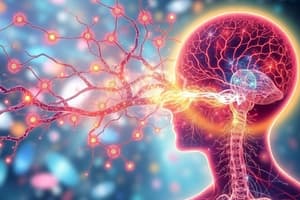Podcast
Questions and Answers
¿Cuántos pares de nervios craneales conforman el sistema nervioso periférico?
¿Cuántos pares de nervios craneales conforman el sistema nervioso periférico?
- 10 pares
- 6 pares
- 8 pares
- 12 pares (correct)
¿Cuál es la función de los nervios aferentes del sistema nervioso periférico?
¿Cuál es la función de los nervios aferentes del sistema nervioso periférico?
- Regular la actividad muscular voluntaria
- Llevar información al sistema nervioso central (correct)
- Controlar el sistema nervioso autónomo
- Transmitir información del sistema nervioso central al cuerpo
¿Qué tipo de información transportan los nervios eferentes del sistema nervioso periférico?
¿Qué tipo de información transportan los nervios eferentes del sistema nervioso periférico?
- Señales del sistema nervioso autónomo
- Información sensorial al sistema nervioso central
- Datos sobre la actividad muscular voluntaria
- Información del sistema nervioso central al cuerpo (correct)
¿A qué se refiere la entrada de información aferente al sistema nervioso central?
¿A qué se refiere la entrada de información aferente al sistema nervioso central?
¿Cuál es la función de la salida de información eferente del sistema nervioso central?
¿Cuál es la función de la salida de información eferente del sistema nervioso central?
¿Qué constituye el sistema nervioso somático?
¿Qué constituye el sistema nervioso somático?
¿Qué caracteriza al sistema nervioso autónomo o neurovegetativo?
¿Qué caracteriza al sistema nervioso autónomo o neurovegetativo?
¿Qué tipo de información transmiten los nervios simpáticos del sistema nervioso autónomo?
¿Qué tipo de información transmiten los nervios simpáticos del sistema nervioso autónomo?
¿Cuál es la función principal de los nervios parasimpáticos del sistema nervioso autónomo?
¿Cuál es la función principal de los nervios parasimpáticos del sistema nervioso autónomo?
¿Cuál es la principal característica del sistema nervioso periférico?
¿Cuál es la principal característica del sistema nervioso periférico?
¿Cuántos pares de nervios espinales conforman el sistema nervioso periférico?
¿Cuántos pares de nervios espinales conforman el sistema nervioso periférico?
¿Cuál es la función principal del sistema nervioso simpático?
¿Cuál es la función principal del sistema nervioso simpático?
¿Cuál es la principal diferencia estructural en el circuito neuronal eferente entre el sistema periférico somático y el sistema periférico autónomo?
¿Cuál es la principal diferencia estructural en el circuito neuronal eferente entre el sistema periférico somático y el sistema periférico autónomo?
¿Qué efectos tiene la activación del sistema nervioso simpático?
¿Qué efectos tiene la activación del sistema nervioso simpático?
¿Qué tipo de neuronas liberan noradrenalina en el sistema nervioso simpático?
¿Qué tipo de neuronas liberan noradrenalina en el sistema nervioso simpático?
¿Cuál es la función principal del sistema nervioso parasimpático?
¿Cuál es la función principal del sistema nervioso parasimpático?
¿Dónde se localiza el cuerpo de la neurona preganglionar del sistema nervioso parasimpático?
¿Dónde se localiza el cuerpo de la neurona preganglionar del sistema nervioso parasimpático?
¿Qué efectos tiene la activación del sistema nervioso parasimpático?
¿Qué efectos tiene la activación del sistema nervioso parasimpático?
¿Cuál es la función del sistema nervioso autónomo simpático?
¿Cuál es la función del sistema nervioso autónomo simpático?
¿Cuál es la principal diferencia entre el sistema nervioso periférico somático y el sistema nervioso periférico autónomo en cuanto al circuito neuronal eferente?
¿Cuál es la principal diferencia entre el sistema nervioso periférico somático y el sistema nervioso periférico autónomo en cuanto al circuito neuronal eferente?
¿Dónde se localiza el cuerpo de la neurona preganglionar del sistema nervioso simpático?
¿Dónde se localiza el cuerpo de la neurona preganglionar del sistema nervioso simpático?
¿Qué tipo de neuronas liberan noradrenalina en el sistema nervioso simpático?
¿Qué tipo de neuronas liberan noradrenalina en el sistema nervioso simpático?
¿Cuál es el efecto de la activación del sistema nervioso parasimpático?
¿Cuál es el efecto de la activación del sistema nervioso parasimpático?
¿Cuál es la función del sistema nervioso autónomo parasimpático?
¿Cuál es la función del sistema nervioso autónomo parasimpático?
¿En qué parte del sistema nervioso periférico se localizan los cuerpos de las neuronas postganglionares del sistema nervioso parasimpático?
¿En qué parte del sistema nervioso periférico se localizan los cuerpos de las neuronas postganglionares del sistema nervioso parasimpático?
¿Cuál es la función del sistema nervioso autónomo simpático en relación con el flujo sanguíneo?
¿Cuál es la función del sistema nervioso autónomo simpático en relación con el flujo sanguíneo?
Flashcards
Peripheral Nervous System (PNS)
Peripheral Nervous System (PNS)
The peripheral nervous system (PNS) is composed of all the nerves that extend from the brain and spinal cord to the rest of the body.
Cranial Nerves
Cranial Nerves
Cranial nerves are 12 pairs of nerves that originate from the brainstem and control sensory and motor functions of the head and neck.
Spinal Nerves
Spinal Nerves
Spinal nerves are 31 pairs of nerves that originate from the spinal cord and control sensory and motor functions of the body.
Afferent Nerves
Afferent Nerves
Signup and view all the flashcards
Efferent Nerves
Efferent Nerves
Signup and view all the flashcards
Somatic Nervous System
Somatic Nervous System
Signup and view all the flashcards
Autonomic Nervous System
Autonomic Nervous System
Signup and view all the flashcards
Sympathetic Nervous System
Sympathetic Nervous System
Signup and view all the flashcards
Parasympathetic Nervous System
Parasympathetic Nervous System
Signup and view all the flashcards
Norepinephrine in Sympathetic System
Norepinephrine in Sympathetic System
Signup and view all the flashcards
Acetylcholine in Parasympathetic System
Acetylcholine in Parasympathetic System
Signup and view all the flashcards
Sympathetic Effects on Heart
Sympathetic Effects on Heart
Signup and view all the flashcards
Parasympathetic Effects on Heart
Parasympathetic Effects on Heart
Signup and view all the flashcards
Preganglionic Neurons
Preganglionic Neurons
Signup and view all the flashcards
Postganglionic Neurons
Postganglionic Neurons
Signup and view all the flashcards
Somatic Neuron Pathway
Somatic Neuron Pathway
Signup and view all the flashcards
Autonomic Neuron Pathway
Autonomic Neuron Pathway
Signup and view all the flashcards
Sympathetic Preganglionic Origin
Sympathetic Preganglionic Origin
Signup and view all the flashcards
Parasympathetic Preganglionic Origin
Parasympathetic Preganglionic Origin
Signup and view all the flashcards
Sympathetic Pupil Response
Sympathetic Pupil Response
Signup and view all the flashcards
Parasympathetic Pupil Response
Parasympathetic Pupil Response
Signup and view all the flashcards
Sympathetic Heart Rate Response
Sympathetic Heart Rate Response
Signup and view all the flashcards
Parasympathetic Heart Rate Response
Parasympathetic Heart Rate Response
Signup and view all the flashcards
Sympathetic Sweat Response
Sympathetic Sweat Response
Signup and view all the flashcards
Parasympathetic Digestion Response
Parasympathetic Digestion Response
Signup and view all the flashcards
Parasympathetic Saliva Response
Parasympathetic Saliva Response
Signup and view all the flashcards




